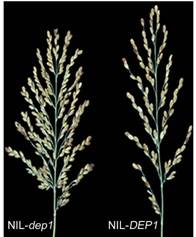Grain yield, the multiplicatively integrating of the components, such as the number of panicles per plant, the number of grains per panicle and grain weight, is controlled by quantitative locus (QTL) derived from natural variations in rice. Since 1980s, many high-yielding japonica varieties characterized with dense and erect panicle architectures have been released in China, such as Shengnong 265. Grain yield is heavily influenced by the architecture of the inflorescence. However, little is as yet known concerning the genetic control of this trait complex in crops. Xiangdong Fu at the IGDB and co-workers have identified the molecular characterization of a major rice grain yield QTL, DEP1. They showed that gain-of-function of dep1 gene enhance the inflorescence meristem activity and promote cell proliferation, resulting in an increased number of primary and secondary branches, an increased number of grains per panicle, and a consequent increases in grain yield (Figure 1). Interestingly, this mutation is common to many Chinese high-yielding rice varieties and is a relatively recent (post-domestication) introduction into rice crop germplasm. The identification of the DEP1 locus offers prospects for gaining a deeper understanding of the molecular basis of panicle branching in rice. As a key regulator of grain number, the DEP1 locus may provide a means of manipulating grain yield in molecular pyramiding breeding in rice.

Figure 1 Panicle morphology of NIL-dep1 plants. Increased panicle branching and reduced rachis length in NIL-dep1 plants than that in NIL-DEP1.



